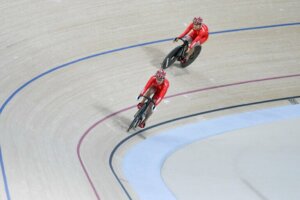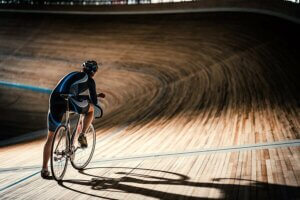The Rules of Olympic Track Cycling

Track cycling is an event where competitors cycle around a velodrome. This is an oval track which is 250 meters long. Read on to find out more about the rules of Olympic track cycling!
This event has very specific rules relating to the bike, the track, and the competitors’ clothing. So let’s take a look at them.
The rules of Olympic track cycling
The bicycle
The type of bicycle used for track cycling is very different from the type used for road biking. For one thing, it has no brakes!
Instead, it has a fixed-gear system so that the pedals are in constant motion. So, to slow down, the cyclist has to pedal slower. This means that you can’t stop suddenly as you’ll just lose your balance.
This also means that the bike has no gears. There’s just a single chainring on the front and a single one on the back. Furthermore, there’s no water holder because the rules prohibit water from being carried on the bike.
The rules also specify that the wheels must be made out of aluminum, carbon, or titanium. Their diameter can vary from 66 to 68 cm (26 to 28 inches). The bike cannot be more than two meters (about six feet) long and must weigh between 7 and 8.5 kg (15 and 19 lb).

Velodrome
The velodrome is an oval track with rounded ends. It’s very important for the velodrome to comply with all the necessary criteria so that there are no setbacks during the event.
The surface can be cement or wood and the length of the track can vary from 250 to 333 meters. There isn’t any restriction regarding whether the track is covered or uncovered.
All the angles of the track can vary, there are some minimum requirements. For example, the width cannot be smaller than 7 meters (23 ft) nor greater than 11 meters (36 ft).
The track also has to have two camber angles which can range between 38 and 46 degrees. This is an important part of the design which allows the cyclists to maneuver the way they do.
In practice, velodromes may have some subtle differences. However, all need to have access to a tunnel, a dressing area, a competitors’ area, a finish line with a video system, and an exit area.
Clothing
The clothing is very strict for safety reasons and any violation may result in penalties. Cyclists need to have an aerodynamic helmet, footwear with a rigid sole that can clip into the pedal, a uniform with the colors of their national team, lycra gloves, and short socks.
Other rules of track cycling
Besides the rules above, the rules state that the officials must be appointed by the President of the Commissaires.

Races are timed to the nearest millisecond and the race starts after a gun is fired. If anyone breaks the rules or engages in unsportsmanlike conduct, they’ll be warned with a yellow flag.
Other basic rules state that cyclists cannot carry any additional objects such as water or food. Furthermore, the number of competitors is limited for safety reasons.
If the track is 1093.5 feet long, a maximum of 36 competitors may compete. But if the track is 820 feet long, this is reduced to 24 competitors. Lastly, if the track is 656 feet long, only 20 people can compete.
Conclusion
As you can see, the rules are very specific and very strict, from the bike to the track, and to the clothing that competitors wear.
Track cycling is one of the most exciting Olympic sports, and it’s becoming increasingly more popular, although it lags behind road cycling in that regard. Now that you know the rules, maybe you’ll want to participate too?
Track cycling is an event where competitors cycle around a velodrome. This is an oval track which is 250 meters long. Read on to find out more about the rules of Olympic track cycling!
This event has very specific rules relating to the bike, the track, and the competitors’ clothing. So let’s take a look at them.
The rules of Olympic track cycling
The bicycle
The type of bicycle used for track cycling is very different from the type used for road biking. For one thing, it has no brakes!
Instead, it has a fixed-gear system so that the pedals are in constant motion. So, to slow down, the cyclist has to pedal slower. This means that you can’t stop suddenly as you’ll just lose your balance.
This also means that the bike has no gears. There’s just a single chainring on the front and a single one on the back. Furthermore, there’s no water holder because the rules prohibit water from being carried on the bike.
The rules also specify that the wheels must be made out of aluminum, carbon, or titanium. Their diameter can vary from 66 to 68 cm (26 to 28 inches). The bike cannot be more than two meters (about six feet) long and must weigh between 7 and 8.5 kg (15 and 19 lb).

Velodrome
The velodrome is an oval track with rounded ends. It’s very important for the velodrome to comply with all the necessary criteria so that there are no setbacks during the event.
The surface can be cement or wood and the length of the track can vary from 250 to 333 meters. There isn’t any restriction regarding whether the track is covered or uncovered.
All the angles of the track can vary, there are some minimum requirements. For example, the width cannot be smaller than 7 meters (23 ft) nor greater than 11 meters (36 ft).
The track also has to have two camber angles which can range between 38 and 46 degrees. This is an important part of the design which allows the cyclists to maneuver the way they do.
In practice, velodromes may have some subtle differences. However, all need to have access to a tunnel, a dressing area, a competitors’ area, a finish line with a video system, and an exit area.
Clothing
The clothing is very strict for safety reasons and any violation may result in penalties. Cyclists need to have an aerodynamic helmet, footwear with a rigid sole that can clip into the pedal, a uniform with the colors of their national team, lycra gloves, and short socks.
Other rules of track cycling
Besides the rules above, the rules state that the officials must be appointed by the President of the Commissaires.

Races are timed to the nearest millisecond and the race starts after a gun is fired. If anyone breaks the rules or engages in unsportsmanlike conduct, they’ll be warned with a yellow flag.
Other basic rules state that cyclists cannot carry any additional objects such as water or food. Furthermore, the number of competitors is limited for safety reasons.
If the track is 1093.5 feet long, a maximum of 36 competitors may compete. But if the track is 820 feet long, this is reduced to 24 competitors. Lastly, if the track is 656 feet long, only 20 people can compete.
Conclusion
As you can see, the rules are very specific and very strict, from the bike to the track, and to the clothing that competitors wear.
Track cycling is one of the most exciting Olympic sports, and it’s becoming increasingly more popular, although it lags behind road cycling in that regard. Now that you know the rules, maybe you’ll want to participate too?
All cited sources were thoroughly reviewed by our team to ensure their quality, reliability, currency, and validity. The bibliography of this article was considered reliable and of academic or scientific accuracy.
- Federación Española de Ciclismo. Reglamento del deporte ciclista UCI. Extraído de: https://rfec.com/index.php/es/smartweb/seccion/seccion/rfec/Reglamento-del-Deporte-Ciclista-Uci
- CONADE. Ciclismo de pista, historia y actualidad. Extraído de: http://conadeb.conade.gob.mx/Documentos/Publicaciones/Ciclismo%20Pista.pdf
This text is provided for informational purposes only and does not replace consultation with a professional. If in doubt, consult your specialist.








